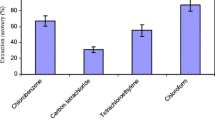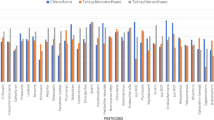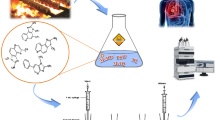Abstract
The dispersive liquid–liquid microextraction (DLLME) was evaluated as a strategy to improve the MIP OES sensitivity for molybdenum determination in lamb meat. Initially, the dispersive (methanol) and extracting (tetrachloromethane) solvents were selected based on a mixture design. The best results were achieved with methanol and carbon tetrachloride as dispersive and extracting solvent, respectively. The operational parameters, such as pH, volume of dispersive and extractant solvents, and complexing agent concentration (8-hydroxyquinoline) were optimized using a Box-Behnken design. The optimal conditions were established as pH 3.8, 90 μL of carbon tetrachloride, 480 μL of methanol, and 1.09 mmol L-1 of 8-hydroxyquinoline. Besides, the use of external gas module control (EGCM) was explored to minimize the matrix effects caused by the organic solvent introduction. The accuracy of the proposed method was estimated employing a certificate reference material (bovine liver, NIST 1577c) and the obtained recovery was 92%. The limit of detection was found to be 0.20 μg g-1, and the enrichment factor was 4.5. The DLLME-MIP OES was applied for six samples of lamb meat, and the results compared to ICP-MS presented no statistical difference. Therefore, the proposed method showed satisfactory accuracy and suitable sensitivity.

Graphical abstract

Similar content being viewed by others
References
Balcaen L, Bolea-Fernandez E, Resano M, Vanhaecke F (2015) Inductively coupled plasma – Tandem mass spectrometry (ICP-MS/MS): A powerful and universal tool for the interference-free determination of (ultra)trace elements – a tutorial review. Anal Chim Acta 894:7–19. https://doi.org/10.1016/j.aca.2015.08.053
Barros JAVA, Angel AA, Kovachev N et al (2016) Vortex-assisted dispersive liquid-liquid microextraction for the determination of molybdenum in plants by inductively coupled plasma optical emission spectrometry. Anal Methods 8:810–815. https://doi.org/10.1039/c5ay02561c
Bizzi CA, Flores EMM, Barin JS, Garcia EE, Nóbrega JA (2011) Understanding the process of microwave-assisted digestion combining diluted nitric acid and oxygen as auxiliary reagent. Microchem J 99:193–196. https://doi.org/10.1016/j.microc.2011.05.002
Carter JA, Long CS, Smith BP, Smith TL, Donati GL (2019) Combining elemental analysis of toenails and machine learning techniques as a non-invasive diagnostic tool for the robust classification of type-2 diabetes. Expert Syst Appl 115:245–255. https://doi.org/10.1016/j.eswa.2018.08.002
Donati GL, Amais RS, Schiavo D, Nóbrega JA (2013) Determination of Cr, Ni, Pb and V in gasoline and ethanol fuel by microwave plasma optical emission spectrometry. J Anal At Spectrom 28:755. https://doi.org/10.1039/c3ja30344f
Donati GL, Amais RS, Williams CB (2017) Recent advances in inductively coupled plasma optical emission spectrometry. J Anal At Spectrom 32:1283–1296. https://doi.org/10.1039/c7ja00103g
Ferreira SLC, Santos HC, Fernandes MS, Carvalho MS (2002) Application of Doehlert matrix and factorial designs in optimization of experimental variables associated with pre-concentration and determination of molybdenum in sea-water by inductively coupled plasma optical emission spectrometry. J Anal At Spectrom 17:115–120. https://doi.org/10.1039/b109087a
Ferreira SLC, Bruns RE, Ferreira HS, Matos GD, David JM, Brandão GC, da Silva EGP, Portugal LA, dos Reis PS, Souza AS, dos Santos WNL (2007) Box-Behnken design: An alternative for the optimization of analytical methods. Anal Chim Acta 597:179–186. https://doi.org/10.1016/j.aca.2007.07.011
Gerber N, Brogioli R, Hattendorf B, Scheeder MRL, Wenk C, Günther D (2009) Variability of selected trace elements of different meat cuts determined by ICP-MS and DRC-ICPMS. Animal 3(1):166–172. https://doi.org/10.1017/S1751731108003212
Goncalves DA, McSweeney T, Donati G (2016a) Characteristics of a resonant iris microwave-induced nitrogen plasma. J Anal At Spectrom 31:1097–1104. https://doi.org/10.1039/C6JA00066E
Goncalves DA, McSweeney T, Santos MC, Jones BT, Donati GL (2016b) Standard dilution analysis of beverages by microwave-induced plasma optical emission spectrometry. Anal Chim Acta 909:24–29. https://doi.org/10.1016/j.aca.2015.12.046
Higuera JM, da Silva ABS, de Oliveira AF, Nogueira ARA (2020) Multi-elemental determination in meat samples using multi-isotope calibration strategy by ICP-MS. Food Chem 303:125395. https://doi.org/10.1016/j.foodchem.2019.125395
Higuera JM, Silva ABS, Nogueira ARA (2019) Multi-energy calibration: a practical method for determination of macro and micro nutrients in meat by ICP OES. J Braz Chem Soc 30:2575–2581. https://doi.org/10.21577/0103-5053.20190171
IUPAC (International Union of Pure and Applied Chemistry). (1997). Compendium of chemical terminology. Page: https://goldbook.iupac.org/.
Lima AF, Da Costa MC, Ferreira DC et al (2015) Fast ultrasound-assisted treatment of inorganic fertilizers for mercury determination by atomic absorption spectrometry and microwave-induced plasma spectrometry with the aid of the cold-vapor technique. Microchem J 118:40–44. https://doi.org/10.1016/J.MICROC.2014.07.012
López-Alonso M, Miranda M, Castillo C, Hernández J, García-Vaquero M, Benedito JL (2007) Toxic and essential metals in liver, kidney and muscle of pigs at slaughter in Galicia, north-west Spain. Food Addit Contam 24:943–954. https://doi.org/10.1080/02652030701216719
Lowery KL, McSweeney T, Adhikari SP, Lachgar A, Donati GL (2016) Signal correction using molecular species to improve biodiesel analysis by microwave-induced plasma optical emission spectrometry. Microchem J 129:58–62. https://doi.org/10.1016/J.MICROC.2016.06.012
Lum TS, Sze-Yin Leung K (2016) Strategies to overcome spectral interference in ICP-MS detection. J Anal At Spectrom 31:1078–1088. https://doi.org/10.1039/c5ja00497g
Macedo SM, de Jesus RM, Garcia KS, Hatje V, de S. Queiroz AF, Ferreira SLC (2009) Determination of total arsenic and arsenic (III) in phosphate fertilizers and phosphate rocks by HG-AAS after multivariate optimization based on Box-Behnken design. Talanta 80:974–979. https://doi.org/10.1016/J.TALANTA.2009.08.025
Machado I, Tissot F (2020) Talanta Dispersive liquid-liquid microextraction as a preconcentration alternative to increase ETAAS sensitivity in the analysis of molybdenum in bovine meat and pasture samples. Talanta 212:120783. https://doi.org/10.1016/j.talanta.2020.120783
Machado RC, Amaral CDB, Nóbrega JA, Nogueira ARA (2017a) Multielemental Determination of As, Bi, Ge, Sb, and Sn in agricultural samples using hydride generation coupled to microwave-induced plasma optical emission spectrometry. J Agric Food Chem 65:4839–4842. https://doi.org/10.1021/acs.jafc.7b01448
Machado RC, Amaral CDB, Schiavo D, Nóbrega JA, Nogueira ARA (2017b) Complex samples and spectral interferences in ICP-MS: evaluation of tandem mass spectrometry for interference-free determination of cadmium, tin and platinum group elements. Microchem J 130:271–275. https://doi.org/10.1016/J.MICROC.2016.09.011
MacLachlan DJ, Budd K, Connolly J et al (2016) Arsenic, cadmium, cobalt, copper, lead, mercury, molybdenum, selenium and zinc concentrations in liver, kidney and muscle in Australian sheep. J Food Compos Anal 50:97–107. https://doi.org/10.1016/j.jfca.2016.05.015
Mansour FR, Danielson ND (2017) Solidification of floating organic droplet in dispersive liquid-liquid microextraction as a green analytical tool. Talanta 170:22–35. https://doi.org/10.1016/j.talanta.2017.03.084
Mertz W (1986) Trace Elements in Human and Animal Nutrition. Academic Press
Moreira LS, Sá ÍP, Machado RC, Nogueira ARA, da Silva EGP, Amaral CDB (2020) Coprecipitation magnesium(II) hydroxide as a strategy of pre-concentration for trace elemental determination by microwave-induced plasma optical emission spectrometry. Spectrochim Acta - Part B At Spectrosc 169:105899. https://doi.org/10.1016/j.sab.2020.105899
Mousavi L, Tamiji Z, Khoshayand MR (2018) Applications and opportunities of experimental design for the dispersive liquid–liquid microextraction method – a review. Talanta 190:335–356. https://doi.org/10.1016/j.talanta.2018.08.002
Nascimento MM, da Rocha GO, Andrade JB (2018) A rapid low-consuming solvent extraction procedure for simultaneous determination of 34 multiclass pesticides associated to respirable atmospheric particulate matter (PM2.5) by GC–MS. Microchem J 139:424–436. https://doi.org/10.1016/j.microc.2018.03.023
Niedzielski P, Kozak L, Wachelka M, Jakubowski K, Wybieralska J (2015) The microwave induced plasma with optical emission spectrometry (MIP–OES) in 23 elements determination in geological samples. Talanta 132:591–599. https://doi.org/10.1016/J.TALANTA.2014.10.009
Ohata M, Ota H, Fushimi M, Furuta N (2000) Effect of adding oxygen gas to a high power nitrogen microwave-induced plasma for atomic emission spectrometry. Spectrochim Acta Part B At Spectrosc 55:1551–1564. https://doi.org/10.1016/S0584-8547(00)00254-8
Oliveira AF, Gonzalez MH, Nogueira ARA (2018) Use of multiple lines for improving accuracy, minimizing systematic errors from spectral interferences, and reducing matrix effects in MIP OES measurements. Microchem J 143:326–330. https://doi.org/10.1016/j.microc.2018.08.032
Oviedo JA, Fialho LL, Nóbrega JA (2013) Determination of molybdenum in plants by vortex-assisted emulsification solidified floating organic drop microextraction and flame atomic absorption spectrometry. Spectrochim Acta - Part B At Spectrosc 86:142–145. https://doi.org/10.1016/j.sab.2013.02.005
Patel N, Bergamaschi M, Magro L, Petrini A, Bittante G (2019) Relationships of a detailed mineral profile of meat with animal performance and beef quality. Animals 9(1073):1–18. https://doi.org/10.3390/ani9121073
Pichler T, Koopmann S (2019) Should monitoring of molybdenum (Mo) in groundwater, drinking water and well permitting made mandatory? Environ Sci Technol 2019–2020. https://doi.org/10.1021/acs.est.9b06869
Pozebon D, Müller A, Dressler VL (2020) Advances of nitrogen microwave plasma for optical emission spectrometry and applications in elemental analysis: a review. J Anal At Spectrom 35:2113–2131. https://doi.org/10.1039/D0JA00272K
Sá IP, Higuera JM, Costa VC et al (2020) Determination of trace elements in meat and fish samples by MIP OES using solid-phase extraction. Food Anal Methods 13:238–248. https://doi.org/10.1007/s12161-019-01615-3
Santos MA, Silva ABS, Machado RC, Dias EA, Barros JAVA, Nogueira ARA (2020) Silicon determination by microwave-induced plasma optical emission spectrometry: considerations and strategies for the use of tetra fluorboric acid and sodium hydroxide in sample preparation procedures. Spectrochim Acta Part B 167:105842. https://doi.org/10.1016/j.sab.2020.105842
Saraji M, Boroujeni MK (2014) Recent developments in dispersive liquid-liquid microextraction microextraction techniques. Anal Bioanal Chem 406:2027–2066. https://doi.org/10.1007/s00216-013-7467-z
Schwarz G, Mendel RR, Ribbe MW (2009) Molybdenum cofactors, enzymes and pathways. Nature 460:839–847. https://doi.org/10.1038/nature08302
Serrano R, Grindlay G, Gras L, Mora J (2019) Evaluation of calcium-, carbon- and sulfur-based non-spectral interferences in high-power MIP-OES: comparison with ICP-OES. J Anal At Spectrom 34:1611–1617. https://doi.org/10.1039/c9ja00148d
Serrano R, Grindlay G, Niedzielski P, Gras L, Mora J (2020) Evaluation of MIP-OES as a detector in DLLME procedures. Application to the Cd determination in water samples. J Anal At Spectrom 35:1351–1359. https://doi.org/10.1039/D0JA00113A
Smedley PL, Kinniburgh DG (2017) Molybdenum in natural waters: a review of occurrence, distributions and controls. Appl Geochem 84:387–432. https://doi.org/10.1016/j.apgeochem.2017.05.008
Smirnova SV, Samarina TO, Ilin DV, Pletnev IV (2018) Multielement determination of trace heavy metals in water by microwave-induced plasma atomic emission spectrometry after extraction in unconventional single-salt aqueous biphasic system. Anal Chem 90:6323–6331. https://doi.org/10.1021/acs.analchem.8b01136
Tanabe CK, Hopfer H, Gilleland G, Liba A, Ebeler SE, Nelson J (2016) Total arsenic analysis in Californian wines with hydride generation-microwave plasma-atomic emission spectroscopy (HG-MP-AES). J Anal At Spectrom 31:1223–1227. https://doi.org/10.1039/c6ja00051g
Tuzen M, Shemsi AM, Bukhari AA (2017) Vortex-assisted solidified floating organic drop microextraction of molybdenum in beverages and food samples coupled with graphite furnace atomic absorption spectrometry. Food Anal Methods 219–226. https://doi.org/10.1007/s12161-016-0571-x
Williams CB, Amais RS, Fontoura BM, Jones BT, Nóbrega JA, Donati GL (2019) Recent developments in microwave-induced plasma optical emission spectrometry and applications of a commercial Hammer-cavity instrument. TrAC - Trends Anal Chem 116:151–157. https://doi.org/10.1016/j.trac.2019.05.007
Acknowledgments
This is a contribution of the National Institute of Advanced Analytical Science and Technology (INCTAA).
Funding
This study was funded by the Fundação de Amparo a Pesquisa do Estado de São Paulo - Fapesp (grant number 2018/26145-9), Conselho Nacional de Desenvolvimento Científico e Tecnológico - CNPq (grants number 153125/2016-0, 141315/2017-2, and 308178/2018-1), and Coordenação de Aperfeiçoamento de Pessoal de Nível Superior – Brazil (Finance Code 001).
Author information
Authors and Affiliations
Corresponding author
Ethics declarations
Conflict of Interest
Ana Beatriz Santos Silva declares that she has no conflict of interest. Ívero Pita de Sá declares that he has no conflict of interest. Julymar Marcano de Higuera declares that she has no conflict of interest. Ana Rita de Araujo Nogueira declares that she has no conflict of interest.
Ethical Approval
This article does not contain any studies with human participants or animals performed by any of the authors.
Informed Consent
Not applicable.
Additional information
Publisher’s Note
Springer Nature remains neutral with regard to jurisdictional claims in published maps and institutional affiliations.
Rights and permissions
About this article
Cite this article
Silva, A.B.S., Sá, Í.P., Higuera, J.M. et al. Feasibility of Dispersive Liquid–Liquid Microextraction for Molybdenum Determination in Lamb Meat by MIP OES. Food Anal. Methods 14, 496–502 (2021). https://doi.org/10.1007/s12161-020-01898-x
Received:
Accepted:
Published:
Issue Date:
DOI: https://doi.org/10.1007/s12161-020-01898-x




